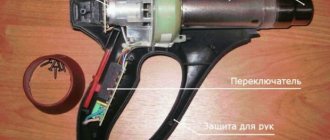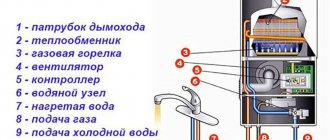The tool is used to create straight grooves in concrete structures, stone and brickwork. Using a wall chaser, communication systems, electrical cables, information wires, and centralized water supply pipes are laid buried in solid walls, floors and ceilings. The device significantly increases labor productivity compared to classic cutting machines.
Purpose of the wall chaser
A wall chaser is a power tool designed for quick and high-quality laying of long grooves (grooves) in walls, ceiling or floor slabs by creating two parallel cuts with diamond cutting discs, the material between which is subsequently removed (hollowed out) using a hammer drill with a special drill or a jackhammer.
This tool is used for sawing longitudinal grooves in the following materials:
- Wood;
- Concrete;
- Foam concrete;
- Aerated concrete;
- Silicate and ceramic bricks;
- Gas silicate blocks.
The grooves made by a wall chaser are used to lay in them such communications as electrical wiring, heating pipes, water and gas pipelines.
Wall chaser rental as an opportunity to save money without sacrificing quality
A wall chaser is an expensive device, and it doesn’t always make sense to purchase it. If you need to move an outlet or make repairs in one room, it’s easier to use someone else’s tool. When buying your own, there is a possibility that after several hours of operation the device will fall into oblivion.
You can borrow a furrow machine from friends or acquaintances, but it is better to rent one. The arguments in favor of renting are very compelling:
- At rentals, the condition of the instrument is strictly controlled. You can take a faulty wall chaser from a private person and think for a long time about who is responsible for the breakdown.
- Clearly defined conditions and fixed fees give a feeling of freedom of use. In other situations, there is necessarily an element of dependence and the need for gratitude.
- When receiving a tool for rent, a specialist will definitely provide a consultation, and the client can clarify all the questions that have arisen and test the device.
Renting a wall chaser with a 125 mm disc will cost about 400 rubles per day
The rental fee depends on the power of the wall chaser and, as a consequence, on the size of the cutting elements, that is, the discs. Renting a 125 mm wall chaser will cost from 400 rubles per day. Delivery may be included in the payment, or may be offered as an additional service.
A 230 mm wall chaser will have a rental price that is 25-30% higher, it will be 600-800 rubles per day.
Important! When renting or handing over a power tool, you should remember that no receipt that is not certified by the relevant authority is not a document and has no legal force.
Device and main characteristics
Tool structure for cutting grooves
KG cable - decoding and technical characteristics
The most common wall chaser for concrete consists of the following main components:
- Electric motor – power unit with an electronic overload protection system, easy access to the brush-commutator unit;
- Gearbox is a mechanism that transmits rotation from the electric motor to the spindle;
- The spindle is a rotating shaft on which two cutting diamond discs are fixed using two adjusting washers;
- Protective casing – protection covering diamond discs with a pipe (connector) for connecting a vacuum cleaner;
- 2 handles (main with a start button and auxiliary) - designed to securely fix the tool in the hands of a worker.
The characteristics of this tool include the material from which the main components are made, weight and linear dimensions, electric motor power, equipment, and the diameter of the diamond blades used.
Material
In the production of wall chasers, materials such as aluminum and plastic are used. The first one is used to make a dustproof casing and gearbox. The motor housing and handles are made of plastic with linings made of a special anti-slip material that effectively reduces vibration.
Dimensions and weight
A wide variety of wall chaser models have lengths from 250-260 to 500-580 mm, heights from 150-160 to 280-300 mm, weights from 3-3.5 to 13-14 kg.
Motor power
Various models of this tool are equipped with electric motors with power ranging from 900-1000 to 2000 W.
The power of the electric motor of a particular model determines the performance of the tool and its scope of application:
- Household - have a power unit power from 900-100 to 1300 W. Used for cutting grooves in small volumes;
- Semi-professional - power tools equipped with motors with a power of 1400-1700 W. Used by electricians and plumbers during construction work of private houses and cottages;
- Professional – models equipped with electric motors with a power of more than 1700-2000 W. Used for gating walls, ceilings, floors in industrial volumes.
The classification of this power tool described above allows you to most accurately determine, taking into account the type and volume of work, which wall chaser is best to choose. So, for one-time work, an inexpensive household model will be sufficient, while when using this tool to perform large volumes of work, it is necessary to purchase a more powerful semi-professional or professional model.
Wall chaser equipment
The equipment of this tool includes:
- Additional dust cover that prevents dust from entering the air when working with the tool;
- 2-4 rollers with a special anti-slip material coating.
Circles for wall chasers
To lay the grooves, special heavy-duty diamond discs with a diameter of 115 to 200-230 mm are used.
Discs with a diameter of 355 mm are used less frequently - they are used when chipping concrete surfaces when laying pipes of large diameters.
The best double-disc wall chasers
The double-disc design allows you to create a groove of the required width and depth. The presence of two or more cutting tools increases productivity by at least two times. The wall chaser cuts straight grooves in any stone-like material. The type of the latter is determined by the technical capabilities of the tool - power and speed. The geometric parameters of the groove depend on the diameter of the disks and the distance between them.
FIOLENT B1-30 – the most inexpensive
A domestically made furrow cutter cuts grooves for cable systems and water supply networks in brickwork and concrete walls. The design allows it to be used as an angle grinder. Replacing it with another cutting attachment turns the tool into a cutting saw for metal. There is a function to maintain constant speed when the load changes.
PROS
- The versatility of the tool.
- Availability of the "Soft start" function.
- Peak overload protection.
MINUSES
- The design is not fully thought out; the housing lock gets in the way when working at an angle.
- The engine is weak.
BISON ZSH-1500 – for building your home
The optimal combination of power and size of the saw blade allows you to choose the tool as the main one when building your own home. The wall chaser perfectly lays grooves for the water supply system, cable distribution, and air conditioning units. The “Soft Start” function eliminates sudden shock impacts at the beginning of the work process.
PROS
- The presence of an additional handle simplifies the work.
- Long service life.
- Convenient system for changing saw blades.
- Price.
MINUSES
- Short cord.
- There is not enough power when cutting concrete to the full depth.
Sparky FK 6526 – the most stable
Powerful and equipped with non-slip rollers, the wall chaser copes well with the resistance of concrete. Easily cuts brickwork. The tool is designed for forming grooves for electrical wiring and water supply pipes. Advanced protection of internal components from dust has been introduced. An additional anti-vibration handle is provided to improve operating comfort.
PROS
- Powerful.
- Stable on horizontal surfaces.
- Smooth start.
- Possibility of working with one disk.
MINUSES
- Very heavy when cutting vertical channels.
- The dust removal system is weak.
AEG MFE 1500 – the most weightless
The lightweight wall chaser allows cutting operations on vertical and ceiling structures. The engine power is quite enough to lay channels for electrical cables, a multimedia system and water pipes. An additional handle increases ease of control. The possibility of a smooth start is provided. The connected vacuum cleaner effectively removes dust from the cutting area.
PROS
- Convenient and lightweight tool.
- Moderately powerful.
- Effectively removes dust.
MINUSES
- The pipe, the area where the vacuum cleaner is connected, becomes noticeably heated.
BOSCH CNF-35 CA - the highest quality
A well-made tool will be useful not only for professional builders, but also for building your own home. It easily overcomes concrete mixtures, brick or stone. Lays grooves for communication systems. The layout of the tool allows you to work on any surface - horizontal, vertical and ceiling.
PROS
- High-quality, solid assembly.
- Ability to adjust power.
- Maintains constant cutting parameters during periodic load changes.
- Ergonomic layout.
MINUSES
- The dust removal system is weak.
Types of wall chasers, their capabilities and price
Do-it-yourself wall chaser - what is it, step-by-step instructions
Depending on the design and functions performed, wall chasers are manual, electric, straight and angular.
Manual
Manual device for cutting grooves
They are a tube with two handles welded perpendicular to it and a staple-shaped cutting element. A similar manual device is used for gating walls made of porous foam, aerated concrete, and wood concrete.
The average cost of such a hand tool does not exceed 500 rubles.
Electrical
Electric scoring tool
This is a large group of wall chasers in which the cutting discs are driven by electric motors with a power of 900 to 2000 W.
They are used for laying grooves in hard materials, for example, concrete, wood species with increased hardness, artificial and natural stone, and various types of bricks.
The cost of such wall chasers, depending on the power of the engine used, equipment and manufacturer, ranges from 3500-4000 (for household models) to 30,000-40,000 rubles (for semi-professional and professional).
Direct
This type is a wall chaser in which diamond cutting discs are located at an angle of 900 to the working surface. They are the most common and often used in various fields.
Corner
Rarely found power tools in which the angle between the cutting discs and the working surface is adjustable. Thanks to this design feature, they are used for cutting grooves in corners.
On a note. In addition to the types described above, there is also a wall chaser attachment for an angle grinder (angle grinder) - a special adapter consisting of a semicircular frame with a connector for a vacuum cleaner, with adjustable cutting depth and two support rollers. Such devices are recommended to be chosen by those who need to perform one-time gating in small volumes without unnecessary investments in the purchase of an expensive tool.
Manual
A manual wall chaser is a carbide cutter bolted to a straight or curved metal frame. For ease of use there are 2 handles.
It is advantageous to use straight wall chasers when chasing horizontal surfaces, and curved ones for walls. Cutting occurs along a marked contour along which the cutting head moves.
Among the advantages of manual varieties:
- simplicity of design;
- low noise level (several times lower than electric);
- affordable price (average price starts from 500 rubles).
But in this way it is difficult to make grooves in hard, homogeneous materials such as stone. The best option is to use it for materials with a porous structure, like cellular aerated concrete.
How to choose a good wall chaser
SIP cable 2: technical characteristics
The main criteria for choosing the right wall chaser are:
- Scope of application - for one-time work, low-power household models are used, while semi-professional and professional wall chasers are suitable for large volumes and constant daily use.
- Weight – when choosing a tool, preference for equal power is given to a model with less weight;
- Availability of additional functions - additional functions such as adjusting spindle speed, sawing depth, and protection against accidental start-up will make the tool more convenient, productive and safe.
The choice of wall chaser is also influenced by the manufacturer’s brand. Experts advise giving preference to models from brands such as Bosch, Metabo, Makita, AEG, Zubr, Fiolent.
When using a wall chaser on wood, concrete or other material, you must remember the following recommendations from experienced specialists and craftsmen:
- Diamond blades should be replaced not one at a time, but in pairs. At the same time, experts advise not to skimp and buy expensive and reliable disks;
- It is strictly forbidden to install disks of different thicknesses and degrees of wear on the tool spindle - this leads to excessive vibration and failure of the gearbox or motor;
- When gating, be sure to connect a powerful vacuum cleaner to the housing connector to remove the resulting dust.
What you need to know about wall chasers?
Good diamond wheels are expensive and, like all consumables, wear out during operation.
Some craftsmen, for the purpose of pseudo-savings, replace one of the disks with a new one, or buy two externally identical ones, but from different manufacturers.
This is strongly not recommended.
The fact is that discs may be similar in appearance, but having different weights and characteristics, will soon lead to tool failure.
Often the reason lies in the imbalance of the spindle, or the different load created.
Wall chaser technique
The process of cutting grooves using a similar tool consists of the following steps:
- Using a long level or rule, a marker or construction pencil is used to make the center line of the groove;
- Cutting discs are installed on the tool;
- Using adjusting washers, the required groove width is set;
- Using the adjustments, the sawing depth is set;
- The reliability of fastening of the protective casing is checked;
- The vacuum cleaner hose is connected to the connector on the casing;
- The tool and vacuum cleaner are connected to the network;
- Sawing grooves in vertical planes is done from top to bottom;
- The groove is finally hollowed out manually using a hammer and chisel or a hammer drill with a special drill bit.
Important! When working with this tool, you must use protective equipment: a painting mask, headphones, gloves, glasses.
Main technical characteristics
The technical characteristics of any tool determine the possibilities of its use, and for electric models of wall chasers these are:
- electrical power - determines performance and can be 1–1.5 kW for models used for personal purposes, and up to 3 kW for professional use;
- weight – directly depends on the electrical power, respectively, the higher it is, the greater the weight of the tool;
- spindle rotation speed – the quality of sawing the surface being processed depends on this indicator; the higher the speed, the better the quality of the cut edges;
- the dimensions of the cut being performed are depth and width, they determine the efficiency and scope of use of the model, measured in mm;
- diameter of saw blades - this indicator is different for different models, which is due to the design of the body and protective casing; its dimensions are standard - 115–230 mm.
The attachment to the “grinder” of the “wall cutter” type expands the functionality of angle grinders, but cannot compare with the performance and cutting quality of a special tool
The weight of wall chasers can range from 3 to 9 kilograms, which depends not only on the power of the electric motor, but also on the design of the device and the materials used in its manufacture. The rotation speed of different models varies, so when choosing a specific device, you need to imagine which materials you will be working with with greater probability and intensity. This is due to the fact that for processing brick, 6–9 thousand revolutions per minute is quite enough, and for concrete this value should be 11–12 thousand revolutions per minute.
Professional models have significant power and large weight
At what price can you profitably buy a wall chaser for concrete?
Let's look at how much wall chasers cost in this section. The table below shows popular models of electric furrowers and their average cost.
Table 2. Cost of wall chasers
| Image | Wall chaser model | Average price (as of April 2021), rub. |
| Makita SG1250 | 25340 | |
| Makita SG1251J | 27870 | |
| Interskol Om 115-1300 | 3100 | |
| Fiolent B1-30 | 5670 | |
| Fiolent B2-30 | 6920 | |
| Bison ZSh-1500 | 8570 | |
| Bosh GNF 35 CA | 39400 |
Dear readers of the online magazine Seti.guru! We invite you to leave your opinion about the use of wall chasers in the comments and share your experience in choosing reliable models
Professional wall chasers
INTERSKOL PD-230/2600E with a large weight (10.7 kg) has an engine power of 2600 W. The rotation speed during operation is 6600, 2 diamond discs are capable of cutting through concrete to a depth of 20-65 mm. The width of the groove varies from 3 to 41 mm. The electronic circuit enables a soft start, maintains operating speed and protects the engine from overloads. The noise level of the operating tool is 108 dB. To work with such a device, a production vacuum cleaner with a power of at least 2 kW and a volume of 30 liters is required.
The model CALIBER MASTER STBE-2600/230M also has a relatively low price. With the same power as the previous model, it has a slightly lighter weight (10.5 kg), revolutions - 6200 per minute, groove width 9-40 mm, depth 20-65 mm. The main disadvantage of the latest models is their heavy weight.
How does a wall chaser work and what is it?
A wall chaser is a power tool designed for making grooves for laying utility lines in the ceilings and walls of buildings made of brick, concrete, stone, and other materials. The design contains a pair of diamond saw blades, thanks to which grooves of a given width are cut.
Wall saw blades
An electric motor of a certain power is installed inside the wall chaser, which drives the disks of the device. The design of the furrow maker is equipped with a supporting movable platform. Thanks to this device, the cutting depth is adjusted. The devices operate from a 220 V electrical network. The tools are equipped with the following protection systems against:
- accidental engine start;
- overheating and overloads;
- jamming of diamond discs;
- dust getting on the internal elements of the structure.
Furrow machines are also equipped with systems for changing the direction of movement, fixing the spindle, rotating speed of the working disks, automatically adjusting the cutting depth, vibration damping and soft start. All this ensures comfortable and safe work for the operator.
Power Tool Accessories and Options
Let's look at the auxiliary systems and possible equipment options that are available in furrow machines. To prevent power tool failure and overheating, many models are equipped with a protection system. It turns off the equipment when specific load parameters are reached. The tool is equipped with protective couplings that prevent jamming of the cutting discs. For these purposes, automatic shutdown is also used, which immobilizes rotating parts of the equipment.
Protective coupling
Since cutting tools are subjected to heavy loads, manufacturers equip wall chasers with systems for reducing vibration and noise, adjusting smoothness and minimizing lateral runout. For example, slip clutches and special shock absorbers are used for these purposes. Professional models of furrow machines are equipped with inrush current limiting systems. They eliminate the rotation of saw blades at the start without jerking and ensure smooth operation of the engine and gearbox.
Vacuum cleaner connection
The wall chasers have special fittings, thanks to which it is possible to connect a vacuum cleaner hose. Non-slip rollers on the tool platform allow you to move the device during operation without much effort. Also, many models are equipped with ergonomic handles, with which it is convenient to hold the tool and install it in various positions.
Non-slip rollers on metal guides











